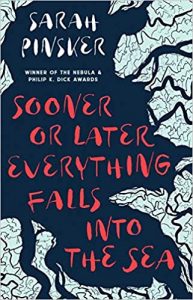It seems this year I have read more than my usual share of science fiction (murder) mystery: The 7 ½ Deaths Of Evelyn Hardcastle, Jane, Unlimited, and Gideon The Ninth all fall into this category in one way or another. And in my scramble to find a novella that I could finish in time for this review, I came across And Then There Were (N-One) by Sarah Pinsker. In the tradition of short genre stories, this one saw the light in an edition of a genre magazine (Uncanny in this case), which means you can read it online and for free here.
With the whole work clocking in at just under 20,000 words, I don’t want to tell you too much about the story other than the very basic premise it opens with, otherwise it becomes too easy to share the whole tale. First, the main character’s name is the same as the author (I will refer to her as ‘main Sarah’ to avoid confusion where possible). Second, the multiverse is real and recently discovered by another Sarah Pinsker, who then (third) contacted multiple other Sarahs to a Sarah Convention. The kicker is: one of the many identical-but-not Sarahs is murdered on the first evening, before the keynote even officially kicks off the weekend’s proceedings. Luckily, main Sarah is an insurance investigator, which is deemed close enough to a homicide detective for the convention’s organisation to request she investigates the death. And so the story begins.
At this point, the story follows the similar pattern of most murder mysteries, with the detective character noting down possible murder weapons a la Clue, and interviewing possible suspects a la Phoenix Wright: Ace Attorney. I use games as a comparison here, because that is how the plot comes across: you can almost picture the video game prompting you to respond with one of two or three options, and there is a desire to keep track of the various clues main Sarah comes across (although I personally have yet to give into this when reading a detective novel or other murder mystery). This worn in pattern is reinforced later in the story, when a character references Agatha Christie, who wrote the murder mystery novel that served as source for this story’s title.
The existence of the multiverse becomes increasingly mindbending as the story plays out, with a deluge of Sarahs pondering its various ripple effects. The prime angle of the convention was to dig into the various differences and overlaps of the various worlds and their various Sarahs, ranging from the serious (why do water scarcity and climate change differ between versions of Earth and how can we use this knowledge to improve the situation on our home world?) to the mundane (why did we choose the pets we did?). Main Sarah repeatedly compares herself to the other Sarahs, as would only be natural, but she also notes this often turns into her making assumptions about the other Sarahs that are only proved wrong through discussions. It seems to me you don’t need to meet a near-clone for this pattern to occur–we all assume similar backgrounds about people who seem mildly similar to ourselves–but when faced with those near-clones, it does become more obvious.
Another important aspect of the multiverse is its divergence points: the points at which the lives of the Sarahs (and the courses of their worlds) start to differ, e.g. through a hospital visit or a returned phone call. While most of these divergence points are relatively small in scale, they can have huge consequences for the Sarahs who made those decisions and possibly for the worlds where those decisions were made. Main Sarah is almost tempted to start questioning her own decisions as a result of comparing herself with the others, but that way madness clearly lies. There are worlds where some decisions are delayed or happened earlier, and if one Sarah made a certain choice there is a world where another Sarah made the opposite choice or a completely different choice or did not choose at all. Every Sarah is a different side of a multi-faceted coin, with plenty of sides not visible (yet). And that doesn’t even touch on the multiverse versions of each Sarah’s loved ones–who are all relatively similar as well.
One of those loved ones is Mabel, main Sarah’s long-term girlfriend. She is ever present in Sarah’s thoughts, and is a recurring partner of other Sarahs we meet (although some decided to stick it out with one of main Sarah’s previous ex-girlfriends). We only meet main Sarah’s Mabel at the start of the story, where they discuss the veracity of the convention and whether Sarah should accept the invitation to attend. Even though we as a reader don’t get much of a sense of Mabel during this scene, she returns in Sarah’s thoughts at various points, always coming across as a calm point or safe haven for Sarah to return to (which makes sense, as she is also serves as Sarah’s main connection to her own world, being the only person in that world who is aware of where Sarah went).
The connection each Sarah has with with her loved ones is a main theme for this story, leading towards the main morale / message: love, be it platonic or romantic or some other variation, trumps all other options in the pursuit of happiness. While it may be a bit saccharine, it’s a message that I readily accept at this time of the year, even if it does come wrapped in a murder mystery as weird as this one.


